Key takeaways:
- Understanding the balance between image quality and file size is crucial for improving website loading times and user experience.
- Choosing the appropriate file format (JPEG for photos, PNG for transparency, SVG for logos) and resizing images to fit display requirements significantly enhances site performance.
- Implementing techniques like image compression, lazy loading, responsive images, and measuring their performance impact can optimize load speed and overall user engagement.
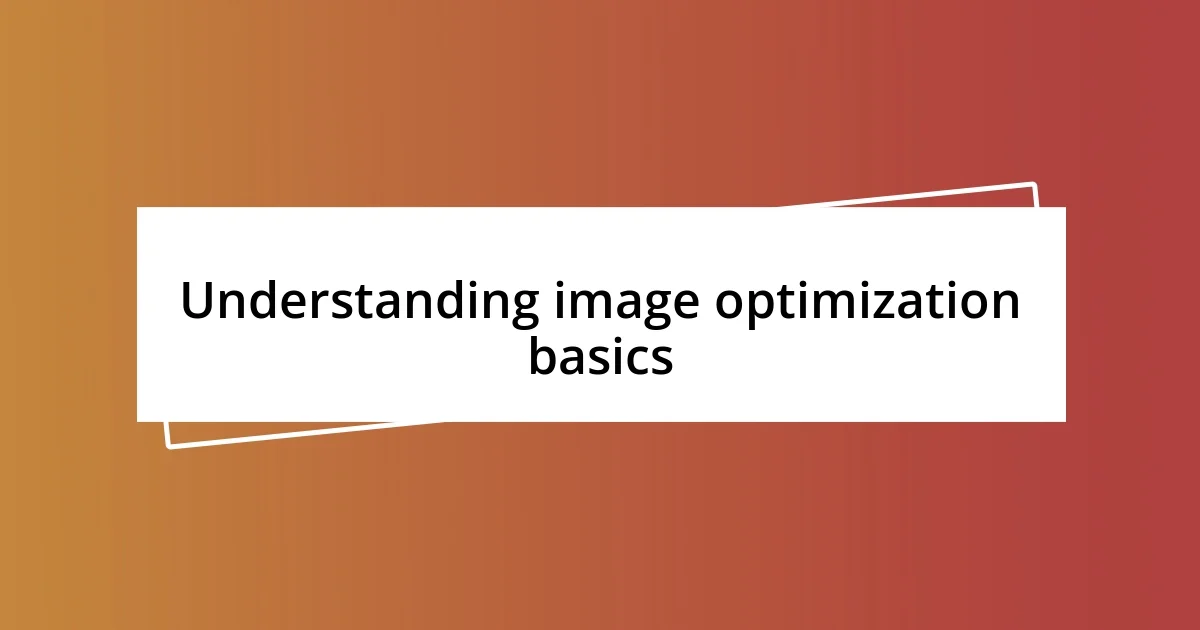
Understanding image optimization basics
When I first dove into the world of image optimization, it felt like trying to solve a complex puzzle. I realized that the key lies in understanding the balance between quality and file size. Have you ever wondered why your website takes longer to load with high-resolution images? It dawned on me that optimizing images can significantly improve loading times and enhance user experience.
One simple habit I developed was choosing the right file format for the right occasion. For instance, JPEG is fantastic for photographs due to its ability to compress without losing too much detail, while PNG works better for images with transparency or when I needed crisp edges. It was a game-changer for my projects. Doesn’t it feel rewarding when you can achieve great visuals without compromising on speed?
Another important aspect is the dimensions of the images I used. I learned the hard way that uploading full-sized images is a surefire way to bog down my site. I started resizing images to fit the display requirements of my site before uploading them. It was a small adjustment, but it made a noticeable difference. Have you tried adjusting image sizes and seen the impact on performance?
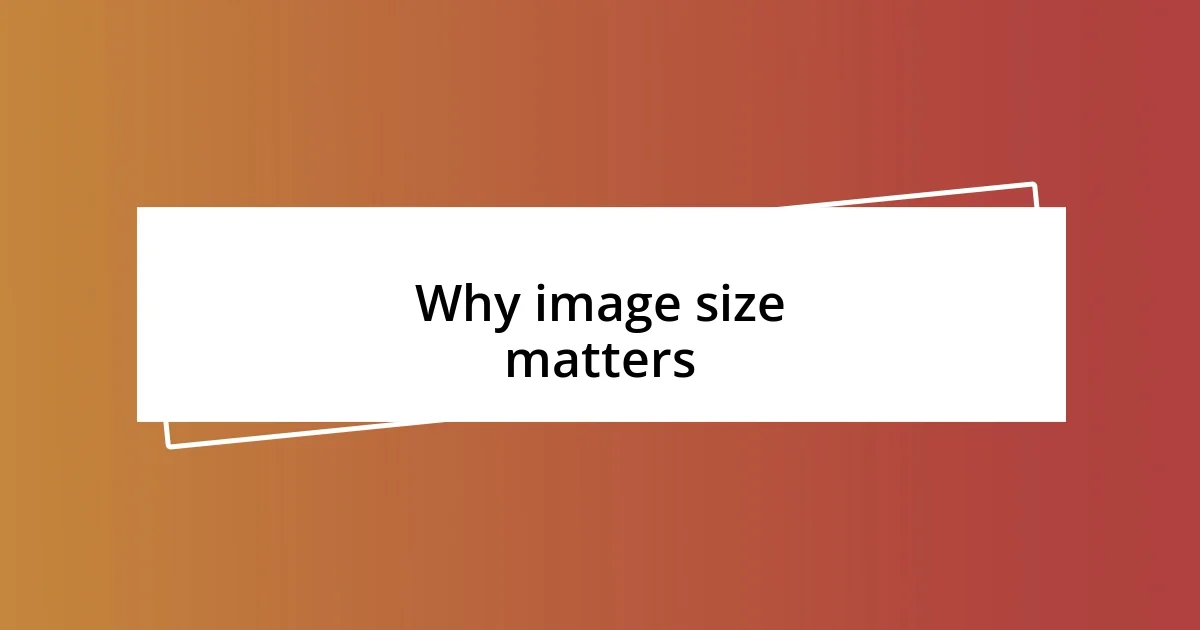
Why image size matters
The size of an image can significantly affect not just how a webpage looks, but also how it performs. I remember when I published a blog post filled with stunning visuals, but I didn’t optimize them. The site lingered on loading, and I felt a twinge of frustration as potential readers bounced away before they could see my hard work. That experience taught me that image size matters for both aesthetics and functionality; it’s all about keeping users engaged.
Here are some reasons why image size is crucial:
- Loading Speed: Larger images take longer to load, which can lead to higher bounce rates—a scenario I personally encountered when visitors left my site out of impatience.
- User Experience: Fast-loading images enhance the overall browsing experience; I felt my own site bloom with this knowledge.
- SEO Benefits: Search engines favor optimized images, helping my content rank better when I took the time to compress images properly.
- Mobile Performance: With more users on mobile devices, adjusting image sizes is vital. I found that images sized for smaller screens retain quality without sacrificing speed.
Embracing these principles transformed my approach to web design, and I found myself excited to share my insights with others!
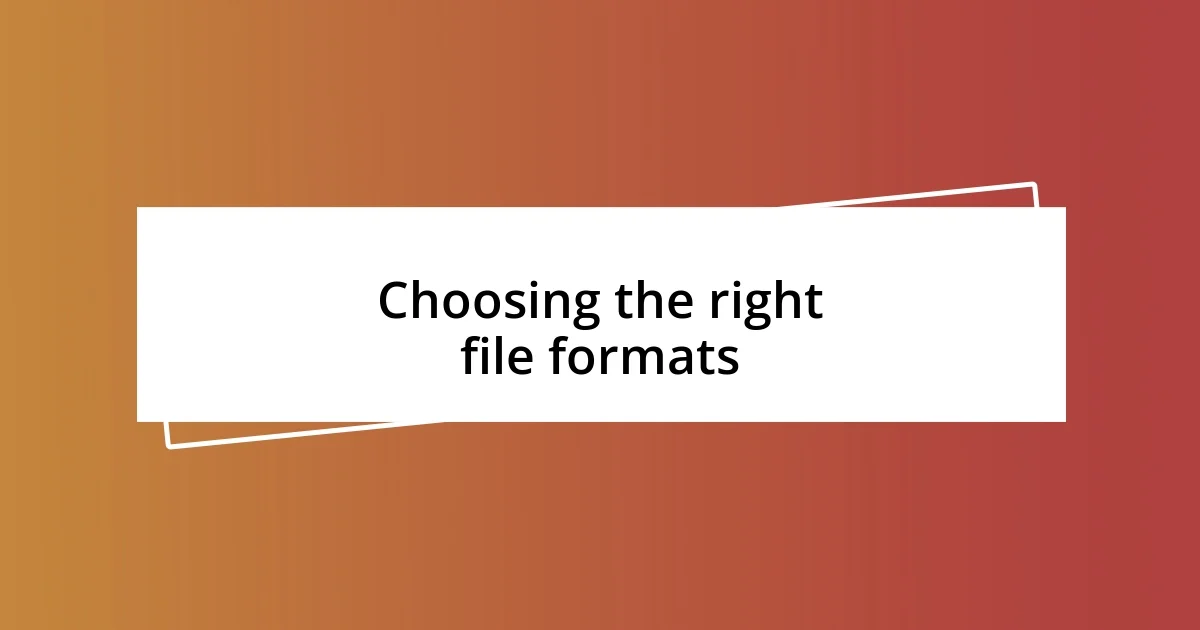
Choosing the right file formats
Choosing the right file format for images is crucial for optimizing your website, and I’ve learned this through trial and error. I remember the first time I used a PNG for a photograph instead of a JPEG; the image quality was fantastic, but the file size was massive. My page load time suffered, and I realized that not every format suits every type of image. Selecting the appropriate format can significantly impact user experience and website performance.
There’s a delicate balance when it comes to file formats. For example, if you’re working with simple graphics or logos that need transparency, going with SVG can be incredibly beneficial. I often found myself stuck between wanting sharp visuals and maintaining a fast-loading site. After some experimenting, I settled on using JPEG for photos and PNG or SVG for graphics, which helped my site load faster without sacrificing quality. It felt like discovering a treasure trove of possibilities!
To make this easier for you, I’ve created a simple comparison of different image formats:
| Format | Best Use Case |
|---|---|
| JPEG | Photographs |
| PNG | Images with transparency |
| SVG | Logos and icons |
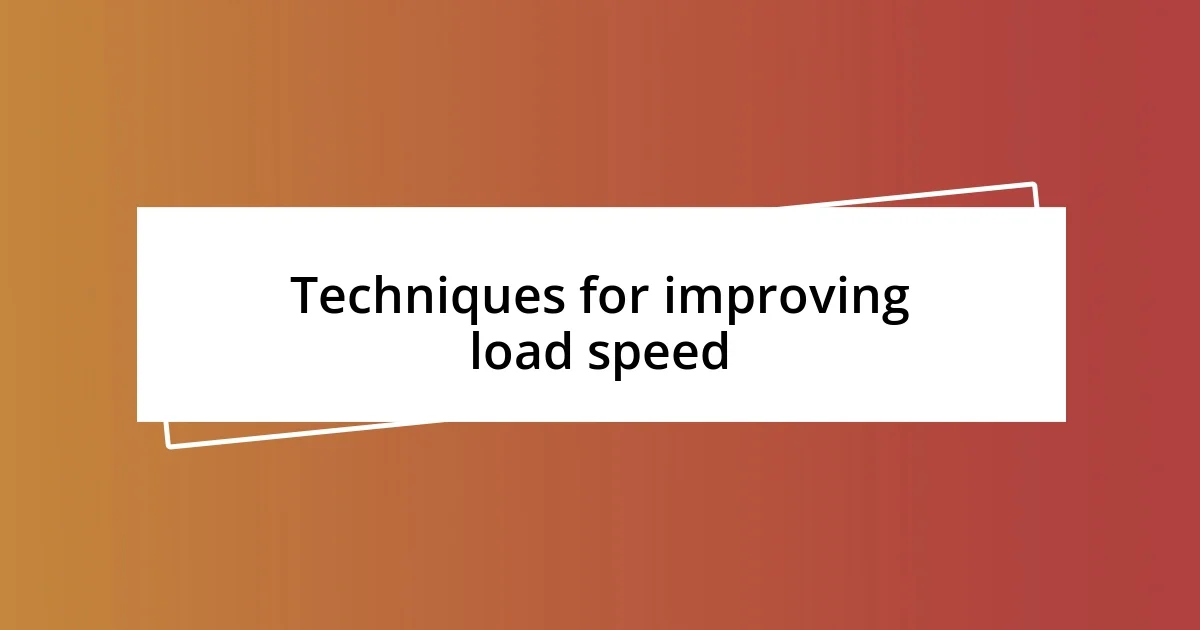
Techniques for improving load speed
When it comes to improving load speed, one technique that I found vital is image compression. I can’t emphasize enough how much I regretted my initial hesitance to compress images. The first time I used a compression tool, I was amazed at how a sizeable image could shrink down to a fraction of the original size while still looking fantastic. It’s like watching a balloon lose its extra air but still retaining its shape. Have you ever felt like your images were dragging your site down? Trust me, compressing those files can make a huge difference in overall load speed.
Another important strategy is lazy loading. I vividly remember visiting sites where images hosted at the bottom of the page took forever to load, causing me to scroll impatiently. By implementing lazy loading, I started loading images only when they became visible in the viewport. It’s almost like letting guests into a party one by one instead of opening the doors to everyone at once. Not only did this bolster my site’s performance, but I felt a genuine delight knowing that my visitors could enjoy a smoother experience.
Finally, I learned that properly defining image dimensions can enhance loading speed. Initially, I often neglected to set width and height attributes for images, leading to layout shifts while the page loaded. This was particularly disheartening when I had worked hard on my design, only to be met with chaos as elements jumped around. By taking the time to specify dimensions, I created a more stable experience for users. Have you ever noticed a site wobbling as you loaded it? It’s frustrating, right? Setting these attributes helped my website maintain its neat presence, allowing users to engage without distractions.
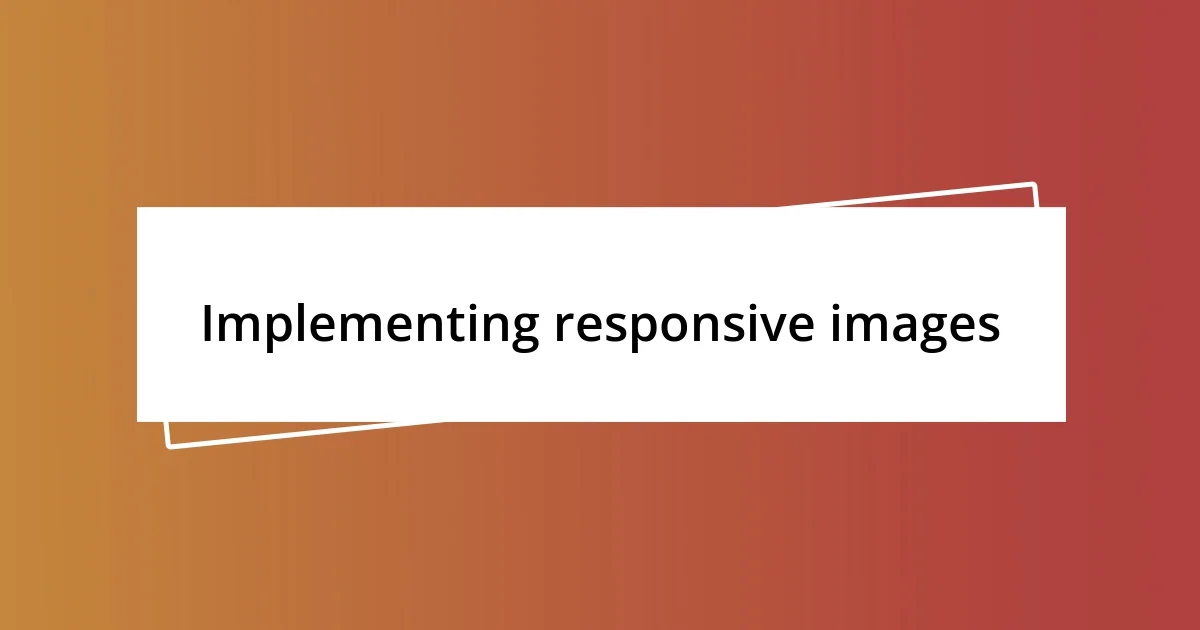
Implementing responsive images
When I first delved into responsive images, it felt like entering a complex maze. The <picture> element was a game changer for me. I remember the moment I discovered it; I could specify different sources for various screen sizes, and it was like pulling a magic lever that adjusted my images to fit seamlessly. This adaptability not only catered to mobile users but also improved load times since only the necessary image resolution was fetched. Have you ever thought about how frustrating it is to wait for a bulky image on a small screen? Using responsive images made my site feel more polished and user-friendly.
Integrating the srcset attribute also brought new clarity to my approach. Initially, I was overwhelmed by options for supplying multiple sizes of an image, but once I set it up, it felt like unlocking a new level of efficiency. I recalled how my heart sank when I saw my beautiful photos diminished to a blurry mess on different devices. Now, with srcset, I could dictate which image to display based on the user’s screen size. It’s such a relief knowing that no matter where my audience is viewing, they’re getting the best possible experience.
Moreover, I learned the importance of the sizes attribute alongside srcset. At first, I didn’t grasp its significance until I realized how it could optimize image loading further. I remember watching my site’s performance improve as I defined how much space images would occupy at different screen widths; it made a tangible difference. Using this attribute felt like setting up a custom wardrobe for my website, where each image dressed appropriately for any occasion. Have you ever curated an outfit that just fits perfectly? That’s how I felt watching my site load faster and look sleek across all devices.
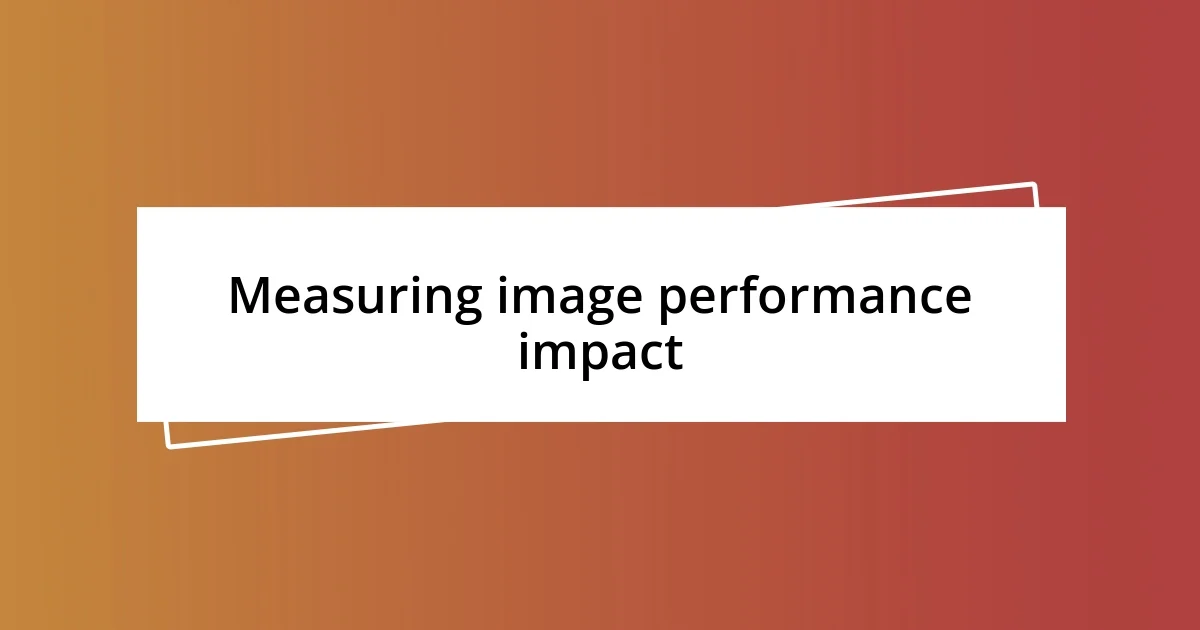
Measuring image performance impact
Measuring the performance impact of images on your website can feel quite revealing. I still remember the first time I ran a speed test on my site and was stunned to see how images disproportionately weighed down my load times. Seeing those numbers solidified my realization that every millisecond counts—especially when users expect instant access. Have you ever been frustrated by slow-loading pages? Understanding the quantifiable impact images have on performance can truly motivate you to make those crucial optimizations.
Using tools like Google PageSpeed Insights became a revelation for me. It was like shining a spotlight on my images, showing me which ones were causing the most drag. I recall the disappointment I felt when I discovered just how much one high-resolution image was affecting my overall score. By addressing those heavy hitters first, I could prioritize my optimization efforts and see tangible improvements. It’s incredible how such straightforward measurements can change your perspective—don’t you agree?
On top of that, I found analyzing user behavior through heatmaps was invaluable. I distinctly remember watching where users scrolled on my pages and realized that many never even saw images buried at the bottom. This insight pushed me to reconsider not just the size of my images but also their placement. By focusing on the images that genuinely contributed to user engagement and cutting those that didn’t, I felt a sense of confidence that my site was now more aligned with what my audience truly cared about. Isn’t it rewarding to feel in control of your site’s performance?














